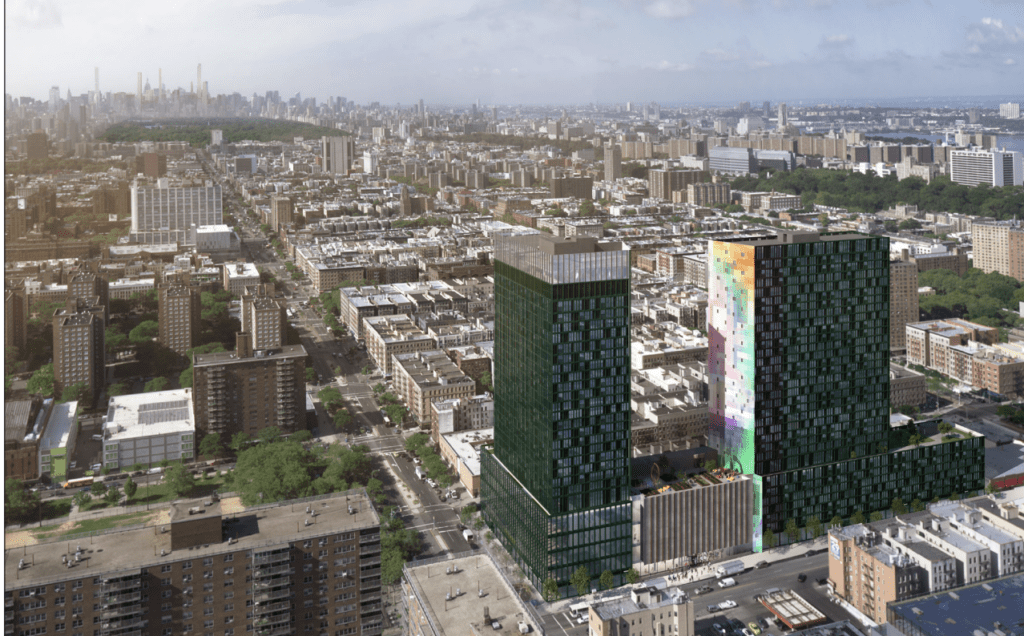Long before scissors cut the red tape of new development, welcoming glass towers, industrial warehouses, and affordable housing complexes to urban communities, YIMBYs and NIMBYs must first compete in a shouting extravaganza of Pay-Per-View proportions.
What is the difference between YIMBY and NIMBY?
YIMBYism, which stands for “yes in my backyard,” and its antithesis, NIMBYism, meaning “not in my backyard,” are two principles that, unlike their calmer and cooler cousins, “Ying” and “Yang,” tend to engender conflict, with either side hurling hyperbolic accusations in defense of its constituents while the other side tries (and often fails) to stay level-headed.
Each side propels an opinion they believe will benefit the greater good. Yet, the two camps have different objectives. YIMBYs are focused on creating density and growth in their communities, often with an emphasis on affordable housing or commercial development, while NIMBYs are focused on maintaining stability and preserving what they’ve built in the community.
Both YIMBYs and NIMBYs have made their presence felt in NYC, where the two camps are at the center of debates about development and zoning. One instance saw the contentious proposal to build an Amazon headquarters in Long Island City. When tensions between the two sides reached a fever pitch, NIMBYs ultimately prevailed, leading to the project’s demise.
But YIMBYs haven’t lost steam. In 2022, the city’s Department of Buildings (DOB) approved the construction of 45,019 housing units borough-wide, according to NewYorkYimby.com. Queens leads the pack with 743 new development projects, many of which will break ground in Long Island City, the very place Amazon considered for its headquarters.
Why Do NIMBYs and YIMBYs Clash?
In New York City, YIMBYs and NIMBYs have engaged in a series of high-profile battles over the years, ranging from the development of Hudson Yards on Manhattan’s West Side to the proposed construction of an affordable housing complex in Soho.
The Soho project aka “Haven Green,” which would provide housing for low-income seniors, has pitted left-progressive NYS assemblywoman Yuh-Line Niou against Habitat for Humanity, the non-profit organization behind the proposal.
Niou, who is 100% NIMBY on the issue, has joined a lawsuit to stop the project. While some Soho community members are upset about the construction taking place atop Elizabeth Street Garden, which has been around for nearly 200 years, Niou’s beef with Habitat lies elsewhere. She argues that Haven Green is an impermanent solution to a much deeper problem: the city’s lack of truly affordable housing. Once completed, Haven Green will go from low-income housing to market rate in 60 years, per the agreement between Habitat and the DOB.
Niou makes a powerful case against the project: In a city with a dearth of low-income housing, why compromise and settle for a short-term solution? Moving forward with the project would be short-sighted, like building a network of upright dominoes for the fleeting satisfaction of watching them all topple.
But YIMBYs make a powerful case, too: What’s more important? They ask. Making sure that seniors, who are among the most vulnerable communities in NYC, have access to safe and affordable housing now (and over the next 60 years) or watching yet another affordable housing project die in committee? Never mind that Elizabeth Street Garden is often closed to the public and that new projects often end up improving their neighborhoods in ways that even some of their most ardent opponents come to appreciate, adding more jobs, more housing, and more amenities than ever before.

Rarely does the debate end in a chorus of Kumbaya, however; there’s just too much passion and too many divergent interests on both sides. Take, for example, the overwhelming NIMBY argument against gentrification.
NIMBYs often see gentrification as a form of displacement, plain and simple, as the gradual transformation of a neighborhood from a primarily low-income area to one that caters to the well-to-do may drive out longtime residents who can no longer afford to live in the ever-more-expensive zip codes. This fear is especially acute in U.S. cities where the job market has been drastically outpacing the capacity for new housing, with San Francisco serving as a prime example.
Some YIMBYs, on the other hand, prefer to see a cityscape bristled with cranes rather than an ever-growing myriad of homeless encampments. To them, infusing the city with jobs and new businesses is a way to make it more vibrant and livable for all. They see value in the revitalization of a neighborhood that could use a little more TLC. They argue that gentrification, when done responsibly and with consideration for local residents’ needs and interests, can yield a net positive.
But the YIMBY vs. NIMBY debate is incredibly nuanced, with divergent interests boiling down to two core questions: 1) How do certain forms of new development impact the needs of the individual and the greater community? 2) And what is each side willing to sacrifice to get what they want?
In a Backyard Far, Far Away
A June 2022 poll by international data analytics firm YouGovAmerica suggested an answer to question number one.
The poll, which surveyed 1,000 U.S. adult citizens, asked what forms of development did they wish to see in their backyards and which ones they’d rather see at the national level instead, many miles away from their homes.
Most homeowners in the survey supported the construction of local amenities that could potentially increase their property values and add to the neighborhood’s allure. They voted “YIMBY” in favor of police stations, charter schools, and nightlife venues, but signed off on “NIMBY” when it came to large-scale projects that may bring about social change, such as homeless shelters and low-income housing.
By contrast, most renters voted “YIMBY” in favor of low-income housing and homeless shelters, according to the poll. They had no skin in the game, as it were, so why band with their home-owning counterparts and keep the status quo? For renters, subsidized housing presented a host of viable solutions that could help alleviate some of the city’s most pressing issues, such as crime and poverty.
Does this mean, then, that renters and other left-leaning voters are pro-social change and homeowners are anti?
Not necessarily.
The same poll showed that, in a country whose prison system is one of the most overcrowded in the world, both renters and homeowners voted “NIMBY” on the issue of building a new jail at the local level and “YIMBY” as long as the prison wasn’t built in their backyards. A similar consensus was reached when asked about waste management facilities, with both camps saying, “Not in my backyard, but thank you,” when presented with the prospect of having one built in their neighborhoods.
By and large, the poll results demonstrate that while the YIMBY vs. NIMBY debate is often viewed as a bi-partisan issue, it’s much more nuanced than that. People’s opinions on development projects are shaped by their unique circumstances, as well as what they think the community needs. What’s best for one may not necessarily be best for another.
More on CitySignal:
Can YIMBYs and NIMBYs Reach a Compromise?
When city council members, assembly persons, and other lawmakers spar with each other at town halls and community meetings, often using rhetoric and hyperbole as weapons, it can be increasingly hard to find a middle ground.
With so many opposing voices drowning each other out, one has to wonder, is there even a middle ground?
In its Spring 2013 issue, the Journal of the American Academy of Arts & Sciences published an essay anthology titled “American Democracy & the Common Good.” In it, authors Amy Gutmann and Dennis F. Thompson contributed a piece on valuing compromise for the greater good. They argued that “pursuing the common good in a pluralist democracy [i.e., a political system where there is more than one center of power] is not possible without making compromises. Yet the spirit of compromise is in short supply in contemporary American politics,” to quote the essay’s abstract directly.
It goes on to say that “a common mistake is to assume that compromise requires finding the common ground on which all can agree. That undermines more realistic efforts to seek classic compromises, in which each party gains by sacrificing something valuable to the other, and together they serve the common good by improving upon the status quo.”
In other words, a successful compromise requires all parties involved to recognize each other’s needs and interests, even if they don’t necessarily agree with them. In the YIMBY vs. NIMBY debate, this means that developers and neighborhood advocates must come to the table and consider each other’s perspectives. Not only that, but they must also be willing to give something up to reach a solution that benefits all involved.
Easier said than done, of course, but in New York City, where urban development has been shaped by the NIMBY attitude for years, some YIMBY-friendly compromises have been reached in recent years.
The city’s 421a program, which provides tax incentives to developers who set aside 20% of their units for low-income housing, has added thousands of affordable homes to the city’s housing stock.
Moreover, NYC mayor Eric Adams, who was elected to office in 2021, is looking to #GetStuffBuilt across the five boroughs and has called on both YIMBYs and NIMBYs to work together to create vibrant, livable neighborhoods for everyone.
But the second question at the core of the YIMBY vs. NIMBY debate is the toughest to answer: What is each side willing to sacrifice to get what they want?
Only time will tell, but in a city where both sides of the debate are deeply entrenched in their positions, mutual understanding and compromise may be the only way for YIMBYs and NIMBYs to get stuff built for the greater good.
Ivan Suazo is a copywriter and SEO blogger with over ten years of experience in the real estate industry. He's also the founder of a wellness blog, QWERTYdelight.com, and writes sleep stories for the Slumber App.



